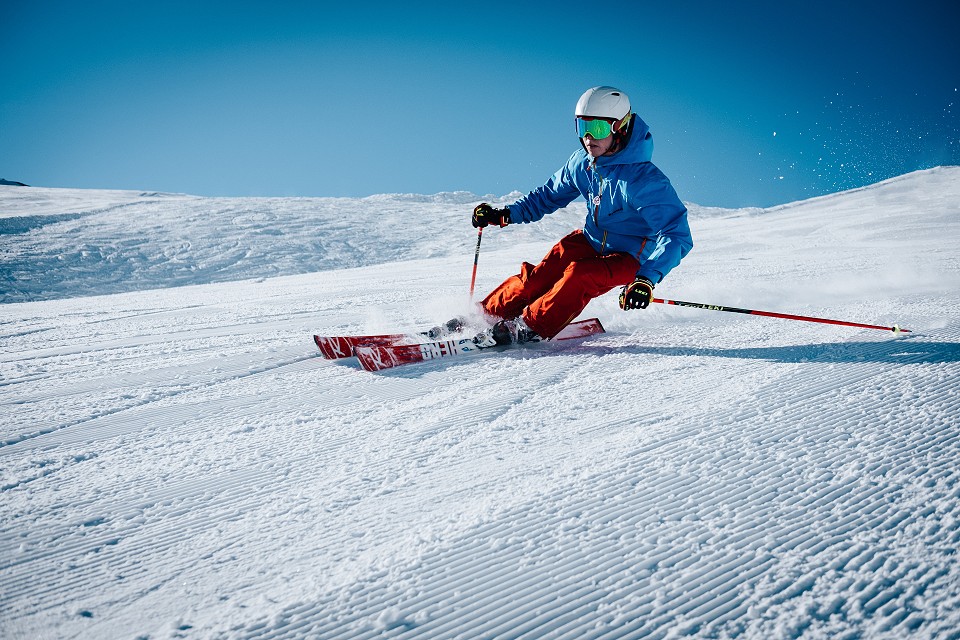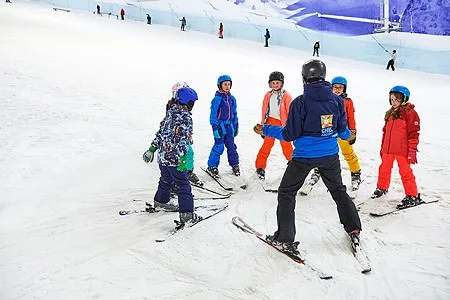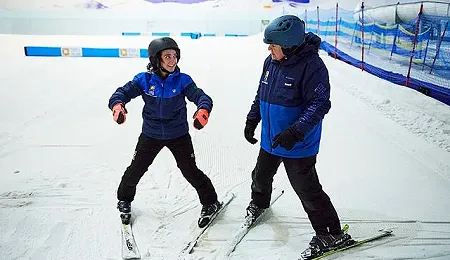The History of Skiing

Skiing hasn’t always been the popular sporting activity it is today. Learning the sport has never been easier, with indoor skiing centres like Chill Factore able to provide an authentic skiing experience. But where did skiing originate, and how did people ski before the sport became popular?
The history of skiing dates back to around 8000 BC, so there is plenty to cover. From being used for hunting and transportation, to playing a pivotal role in World War II, to becoming a Winter Olympics staple, the history of skiing is fascinating and long. So before you book your next ski lesson at Chill Factore, why not learn all about the sport you love?
When was skiing invented?
The act of skiing is not a modern concept. Strapping two skis to your feet to move around in snow has been depicted in cave paintings dating back to the Ice Age. The exact origins of skiing are unknown, but our oldest ancestors’ cave paintings depict them using skis to make transportation more accessible and aid in hunting.
The Sami are credited with inventing skiing back in the Middle Ages. The Indigenous people of Scandinavia were believed to ski across their frosty wetlands and be able to hunt when winter came and everything froze over. Northern China is credited with creating the first pair of skis, dating back to 8000 BC. The skis were made from two-metre-long pieces of wood covered in horse hair.
The evolution of skiing
It wasn’t until the 1700s that history recorded skiing as being used for more than just hunting. The Norwegians adapted skiing for military purposes, and by the 1760s, skiing had become commonplace as a sport and leisure activity.
The origins of what we know as Nordic skiing date back to the beginning of the 1800s with the Norwegian army; the force would hold competitions that involved skiing down slopes, navigating forests, and heavy snowfields while shooting guns. These trials are reminiscent of the biathlon, which remains a fixture of every Winter Olympics.
Norway is also the location of the first recorded ski jump, another Olympic staple. In 1809, a man named Olaf Rye flew just short of 10 metres through the air in front of onlookers and survived to tell the tale.
How the ski developed
As skiing became more popular, skis rapidly evolved from thin slabs of wood to the cambered ski, which more closely resembled the skis we know today. Invented in Norway, the newly designed skis helped distribute weight more evenly and also solved the issue of people sinking into light snow.
The telemark ski came along in 1868, invented by Sondre Norhei. The ski was an evolution of the cambered ski that featured a distinctive side cut, allowing skiers to turn easily instead of sliding in a certain direction. Being able to control the skis saw the sport gain even more popularity, and due to the massive developments found by the Norwegians, two skiing techniques were named for the Norwegian mountains that saw their creation: Christina and Telemark.
Skiing’s big boom
When looking at the history of skiing, the 1900s are when the sport grew from a smaller community-driven activity across Scandinavia to a beloved sport worldwide. In 1924, the first Winter Olympics were held in Chamonix, France. Ski jumping was one of the events, with Norwegian Jacob Tullin Thams taking gold with an 18.960-metre jump. Fellow Nordmenn Narve Bonna took silver with an 18.688-metre attempt, and finally, the bronze went to American Anders Haugen, who landed a 17.917-metre jump.
In the 1930s, skiing began to be adopted worldwide. People had already begun skiing in Europe and North America, but the 30s saw countries including Argentina, New Zealand, Japan, and China take up skiing. Downhill skiing was added to the 1936 Winter Olympics in Germany, and the same year, the world’s first chair lift was installed in Idaho’s Sun Valley.
Skiing’s role in WWII
At the outbreak of World War II, the Soviet Union attempted to take over Finland. Seeing it as an easy conquest, the Soviets became locked in a bitter fight that lasted for three months. The vastly outnumbered Finns held their own, partly thanks to their ski troops.
The rough, forest-covered lands of Finland made it all but impossible to use large machinery like tanks, but the terrain did lend itself to the fast-moving Finnish ski troops, who played a major role in holding back the Soviets until March 1940. The overwhelming odds exhausted the Finnish Army, which eventually signed the Treaty of Moscow and ceded 11% of its land to the Soviet Union.
The Finns weren’t the only ones strapping on the skis for a fast-moving mobile force. The 10th Mountain Division was the United States Ski Division. Their specialised training saw them perfectly suited to pulling off daring assaults against the Nazi forces located in the Alps by the Italian border. The division had one of the highest casualty rates of all across the war, with close to 1,000 members being killed in action.
Skiing’s modern history
Following the Second World War, skiing remained a popular sport, appearing in the Winter Olympics and becoming a popular leisure activity. In 1969, the sport gained further popularity after being heavily featured in the James Bond classic On Her Majesty’s Secret Service.
Freestyle skiing became a recognised sport by the International Ski Federation in 1979. It was included in the 1988 Winter Olympics, the same Olympics that saw crowd favourite Eddie the Eagle debut for the first time.
A year later, in 1989, the first snow park was built in California’s Bear Valley. Snow parks began to spring up all over the world in the 1990s, becoming popular tourist destinations for budding skiers.
Ski resorts have continued to evolve, and now the sport that began life as a tool for hunting during the Ice Age sees thousands of people racing down mountain slopes across the world every day. Skiing has never been more popular, so if you are thinking about picking up the sport for fun or want to become a professional and compete at the Winter Olympics, there is no better place to learn than at Chill Factore.
Discover the world of skiing at Chill Factore
There is no better feeling than rushing down a slope and feeling a breeze on your face. If you are a seasoned skier looking for a place to freestyle ski or you are just starting out and needing ski lessons for beginners, then do not worry. We have the best ski instructors right here, ready to help you with adult ski lessons and kids skiing lessons taken at your pace. Our private ski lessons are perfect if you want a more one-on-one lesson to help hone your skills.
Make your mark in the future of skiing at Chill Factore. If you have any questions about our ski lessons or any of our services, then be sure to contact us, and a member of our team will be happy to help.












